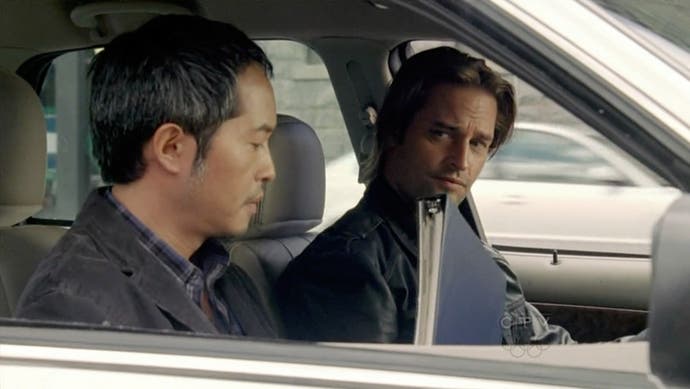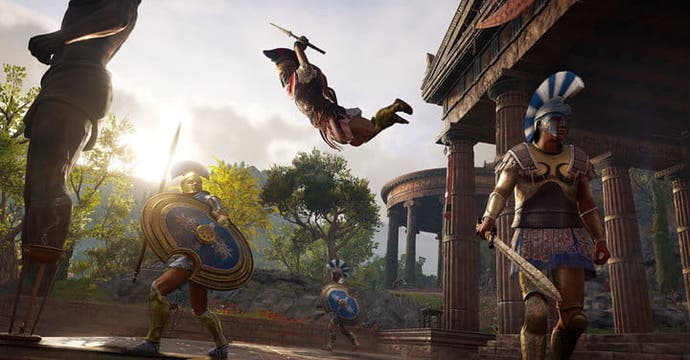Gaming's familiar faces
Cloud Atlas syndrome.
What's the statute of limitations on spoilers? I can't be sure, so be warned: I'm about to spoil certain aspects of the final season of Lost. If you haven't seen it yet, look away now.
I will be brisk, at least. In the final season of Lost, which I've been watching for the first time just now, a group of characters, who have spent much of the previous five seasons marooned on a strange island, start turning up in Los Angeles. Familiar faces - we've spent five years with these faces by this point - but now the details are all different. One of them suddenly has a teenaged son. Another's toxic relationship with his father is now toxic in a different way. Some of them have different jobs - Sawyer and Miles: Supercops! is a spin-off I would have set the recorder for - and some of them are entirely different people. But they're also, in some strange way, the same people they've always been. They stare out of the screen through the same eyes, they say their lines with the same weight and rhythm and intonation.
Lost gets a bit Cloud Atlas, in other words. In David Mitchell's playful novel a handful of distinct souls are shuffled around through matryoshka'd stories that explore different periods of human history and different literary genres. The details change, and in the wonderful/awful/wonderful film version, the wigs and rubber noses are shared about, but the souls can always be traced and the same theme of predation remains.
The thing is, Lost had Cloud Atlas syndrome even before it openly acknowledged it. As a piece of serial television, it is already filled with people who have appeared in other pieces of serial television, and movies, and probably infomercials and video games. Sayid, for example. I have loved Naveen Andrews ever since I saw him in Wild West in the 90s, and I remember him being brilliant in The English Patient too. He brings all of that to Lost for me - how could he not? It's as much a part of his performance, for me at least, as the way in which he looks a bit like my friend Aaron from university. The accent has changed - actually, sometimes Naveen forgets to do the accent - but Aaron is still there in Sayid.

And this ripples outwards. For years I have been seeing Terry O'Quinn in bits and pieces, and now, in the bits and pieces I'll see him in in the future, there will always be a bit of Locke in there, alongside his wonderful Howard Hughes from The Rocketeer. I will keep my eyes peeled for Yunjin Kim, who has been a highlight, and I'll probably find myself in some foreign hotel watching terrible cable years from now and shedding an unexpected tear because Desmond has just popped up on telly selling shampoo. This history - the actor's history - does something very weird as they are shuffled in and out of roles. Everything gets richer, because the axons and dendrites of context get thicker and more deeply entangled.
Does this happen in games? I think it does, but in a different kind of way. Sure, there are recurring actors in games - and a handful of voices that perhaps crop up a bit too often - but that's not really what I'm talking about. In games, the stuff that gives me the same warm, quiet buzz of recognition tend to be things rather than people. I've been playing a big forthcoming game this week and I've already spotted a menu I already know and I've spotted mechanics, power-ups, even animations that I recognise from other games. Is this copying? I suppose it is, but it's also convergence. At its most harmless it's the way that games seem to evolve across titles and platforms. They borrow bits and pieces from the things that have worked before and over time they start to change them slowly, but the lineage remains intact.
I guess what I'm saying is, the gaming equivalent of Terry O'Quinn is probably a radial menu. Because this, I suppose, is how games often convey their character - in the UI, in the way that a mechanic works, in the way that a button press creates a certain feeling and in the way animation is employed to lead the player into a specific way of thinking.

It can be fun to spot the connections between these things, to chart the way a mechanic has moved through games, trigger-targeting from Zelda cropping up in Crackdown, for example. A friend of mine pointed out a few years recently that Pac-Man had one of the first hit-pauses. Elsewhere, an idea like recharging health may crop up everywhere now, but it's interesting to see that, for the first few installments, not even Halo itself could quite decide on how exactly it should work.
And at times, in amidst all this, you get to see the character of the designer, too. So many of the Minor Key games - Eldritch, Slayer Shock - explore their designer's preoccupations as well as the games they love. And they use the same engine, too, which gives every game a shared sense of place - chunky, lonely, uncanny. Equally, I've been playing Holedown on iOS recently and in its interplay of resources it brings to mind Rymdkapsel and Twofold Inc., Grapefrukt's previous work.
Games are supremely complicated, of course, so this can sometimes be knotty territory - the lines between cloning and the basics of a new genre emerging are notoriously difficult to unpick, for starters. But somewhere in the more innocent ways that one game will take from another - ideally adding their own spin and making the gene pool richer for the games that follow - you get an emerging richness. All said, it sort of reminds me of Naveen Andrews. Wait, where have I seen him before?

